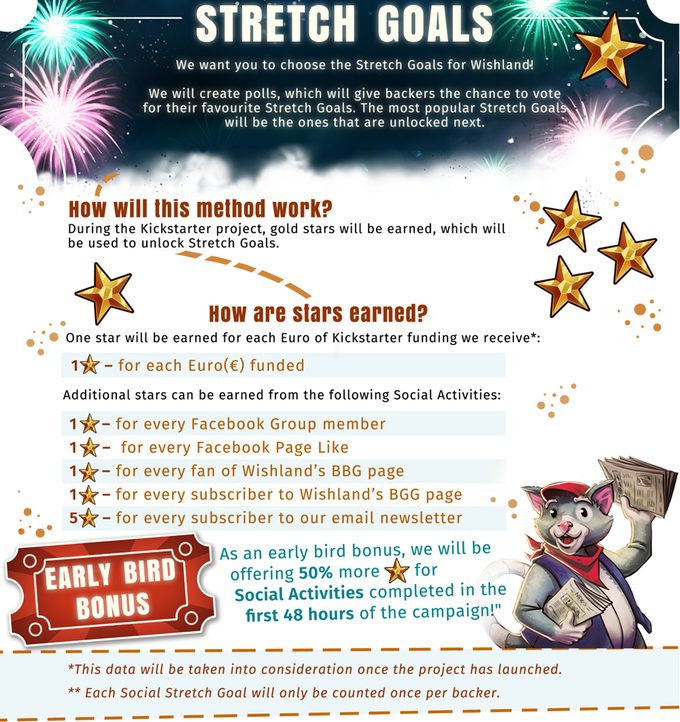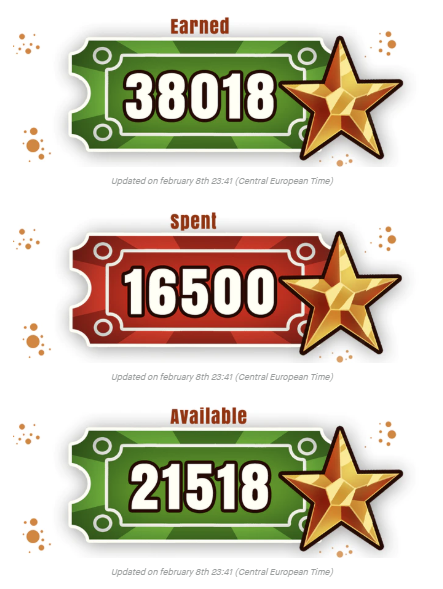Last month I wrote about how much I like Starbuck’s reward system, and I proposed a Kickstarter stretch-goal method inspired by it. If any creators wanted to try it, I asked them to share their experiences with me so I could share them with you.
Fortunately, we didn’t have to wait very long, as Carlos Michan liked the idea for his Wishland Kickstarter project (which is live through February 25; I highly recommend backing it even just to follow along to see this system in practice). His project is currently 400% funded, and he’s shared his feedback with me as a list of pros and cons. I’ll post a summary of them below.

 Pros:
Pros:
- The system encourages backer participation. For example, 141 people have indicated their preference on yesterday’s poll–that’s 20% of backers, which is fantastic.
- Backers have a sense of ownership and pride, as they’re making decisions that impact the final product. This also shows that the creator cares about what they think and want.
- Backer votes and comments give the creator clues about what they value for future goals.
- The social media response has been great, as backers are encouraged to share and discuss the project online.
- Backers get something every day (a decision via the poll, new possibilities for future polls, or poll results), which ensures that the stretch goals aren’t all achieved too soon. Because the goals themselves are in flux, the creator also has a lot more flexibility to create/share new goals later in the project.
- Backers get a real measure of how expensive different stretch goals are (the star cost of each goal is listed next to it in the poll), and they can decide accordingly using the available stars.
Cons:
- People discovering the project near the end of the campaign may feel like they missed a chance to impact the project.
- The system could create confrontation between backers who value different goals.
- Backers can feel disappointed if they aren’t excited about the majority decision in a poll. Even though their preferred goal may appear on a future poll, they might feel like they’re losing stars.
- Some backers were impatient to unlock more goals, particularly early in the project. I think you could get around this by offering some high-star goals early in the project so backers can use big chunks of stars right away. Also, my proposal for the poll in the last 48 hours of the project is that it can unlock multiple goals (instead of just 1) if there are enough stars.
Carlos is using Strawpoll.me for the polls, and I asked him why he wasn’t using BoardGameGeek (as this article indicates, creating engagement on BGG can move your game onto the hotness list, which gets it in front of many more eyes). Carlos made the good point that not all backers have BGG accounts.
Overall, Carlos says that he thinks the pros well outweigh the cons, and he’s very happy with the system. As a backer of Wishland, I can honestly say that I’ve felt more engaged by it than any project in a long time. I get so many project updates these days that I rarely read them, but I’m excited every time I get a project update for Wishland so I can see what we unlocked (though I wish Carlos would add a visual to the update show what we unlocked) and what’s on the next poll.
What do you think? Please keep me in the loop if you try a similar method with your project!
***
While we’re on the subject of stretch goals, Cody Thompson of Gold Nugget Games had an interesting observation about the release schedule of The Mandalorian on Disney+ and how it created a huge amount of buzz throughout the show.
Basically, the first two episodes aired within 3 days of each other. Then there was a regular 7-day release schedule….until the final two episodes, which were separated by 9 days.
It’s an interesting strategy, and I think most of it applies well to Kickstarter stretch goals. But while the final stretch worked to generate conversation for a show as big as The Mandalorian, having a big gap at the end of a Kickstarter would probably make it feel like nothing is happening during that time. What do you think?
***
If you gain value from the 100 articles Jamey publishes on his blog each year, please consider championing this content!
14 Comments on “The Starbucks-Inspired Star Stretch Goal System in Practice”
Leave a Comment
If you ask a question about a specific card or ability, please type the exact text in your comment to help facilitate a speedy and precise answer.
Your comment may take a few minutes to publish. Antagonistic, rude, or degrading comments will be removed. Thank you.


I really like the Idea but I am not sure if I miss something. Isn’t it an enormous effort to track how many stars people have and spend? How does the effort scale?
It’s not that each person has stars–it’s that all backers as a collective group have stars. Check out how Wishland did it.
Great to see your idea was implemented in a campaign so quickly and to see the results!
Definitely thinking about this and how it could be applied to my future campaign.
Fair point Jacob.
I think that can be one, if not the biggest downside to this system.
However, as you get experience in the system and listen to your backers feedback. You can add those upgrades to your project your backer likes more.
The system gives more freedom for both sides, backers and creators. And I agree with you that many can feel that way.
Thanks for sharing!
We did this back in 2017 for the game HELDENTAUFE. Back then we didn’t use fancy graphics (a shame!), most of our updates were plain text. I didn’t think of it as „Starbucks method“ because for me, as a German, Starbuck is not very present. Bu I thought of it as a entertaining, gamified reward system. See: https://www.kickstarter.com/projects/heldentaufe/heldentaufe-the-adventure-board-game-for-the-whole/posts/1491710
The goal for the COMMUNITY STRECH GOAL (we didn’t use the method for regular stretch goals) was set at 1000 Action Points. For different possible actions we rewarded 1 Action Point each.
Con: Soon enough we realized that the first backers have a limit to how many Actions Points they can contribute. A person can’t like your account 5 times …
Pro: To keep this interesting and help us further, we offered new ways to earn Action Points with every new update. Like new pictures on BGG to thumb up etc. that way the same people that already contributed Action Points were able to contribute more.
Will we do this again? We are launching two campaigns this year, for LOST LIGHTS and GREASE MONKEY GARAGE. I am fairly certain we‘ll find a way to add a layer of gamification to their reward systems :)
That’s awesome, Daniel! Thank you for sharing.
Personally, I don’t like backer polls. I’m usually in the minority so I end up feeling disenfranchised and overlooked. I’ve also noticed in projects that I’ve backed that excitement can turn into disappointment when design choices don’t go your way. After several polls I find myself checking out and just not caring anymore.
For example, in one project I backed the designers put up a poll for designs for a new character. There were 3 or 4 choices and in the end the most generic (IMO) design was selected. The problem was that even though the design was the most popular, only ~30% of the backers voted for it. So in the end around 70% of the backers were disappointed by the design. Had the designers just made a decision and presented it to the backers I think most would have been excited.
I agree. This is why I don’t like polls either. I have to admit that it’s fun to participate … but not so much to realize that you are the only one voting for what you wanted ;)
This was very similar to the stretch goal process used by Jay Cormier for the “Fail Faster Playtesting Journal” last year (https://www.kickstarter.com/projects/mindmgmt/fail-faster-the-playtesting-journal).
As the campaign advanced, badges were earned and voting was used to determine which upgrades were prioritized. I believed it went over really well with the backers, too!
First of all a big thank you! to Jamey for thinking of a very original system.
Hi Jonathan,
Thanks for the kind words :)
For every 1000 stars we are adding 100€ to Wishland.
This is really pretty cool. It’s great to see new things being tried! Since you obviously can’t pay manufacturing costs in “stars”, I’m curious how Carlos determined the number of stars each stretch goal should be. It looks like 44 stars for the game and maybe up to an additional 9 stars per backer, so roughly 53 stars/backer.
Was the formula something like: for every 100 units produced, the cost/unit was lowered by $0.10, so for 5300 stars Carlos could add $0.10 worth of product?
To be honest, I looked at this campaign when it launched, and my first thought was “this is the most complicated stretch goal campaign I’ve ever seen”. It feel like way too much work for me. Maybe I’m not the target person though, as I barely pay attention to stretch goals anway. But when I do, I like when they are either daily reveals or $ based. I don’t really want to hunt down a bunch of different numbers to see where things were at.
and FWIW, the Mandalorian last two episodes were 9 days apart because they didn’t want the episode to drop on friday and compete with the opening of Rise of Skywalker :)
Tony: That’s really interesting to hear. Have you looked at the polls? While I haven’t gotten caught up in how stars are earned, I think the polls themselves are extremely streamlined and easy to understand (especially the value proposition of each goal).
To be honest, I didn’t. I browsed around the page and got to the stretch goal section, thought it was overly complex and moved on (not just for that reason).
Like I said, I might not be the right target because I rarely vote in stretch goal polls anyway. Make a great game and send it to me. That’s all I need. Most stretch goals feel like a marketing gimmick now anyway.